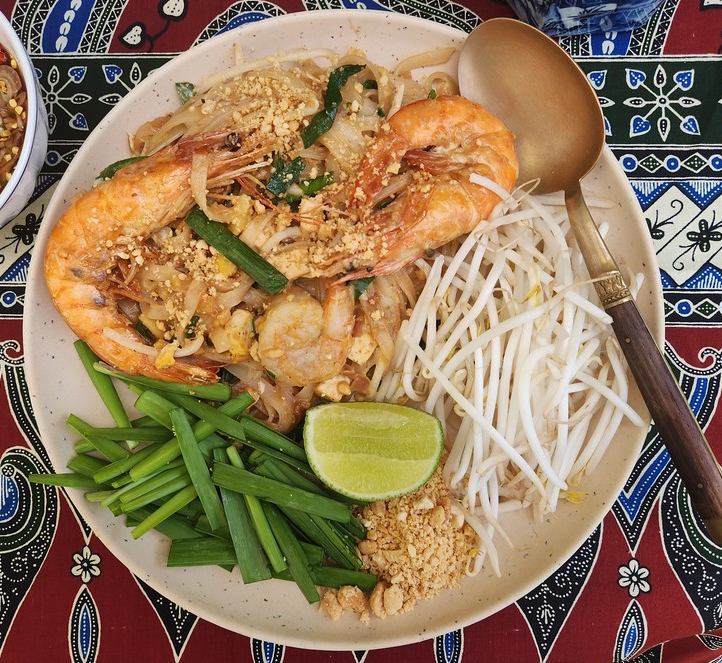
Cuban Lechon Asado con Congri (Cuban roasted pork with rice and beans) is bound take you on a tasty tropical journey. Cuban cuisine is a blend of native Caribbean (Taino), Spanish and African cooking because of the island's history of Spanish colonialism, which for more than two centuries was dependent on slavery. Roasting, grilling and cooking over a slow flame are all common techniques. The distinctive flavor of many Cuban dishes is created through the use of sofrito, a quick-fried combination of olive oil, green peppers, onion, garlic, oregano and black pepper. Many meats are marinaded in spiced citrus juice before grilling or roasting slowly. The goal is to have the meat become succulent and tender, falling off the bone. Seville or bitter oranges are the most used citric juice, but are highly seasonal, so a combination of lime and orange juice can be substituted. The marinade is called mojo. Another common complement to Cuban meals are root vegetables such as yucca, malanga (the plant is often referred to as elephant ear) and boniato (Caribbean sweet potato), which are sliced and marinaded in a combination of lemon juice, garlic, cumin, onions and olive oil.
Rice and beans are required by custom for many Cuban meals. They are usually prepared either together in one pot (congri) or cooked separately as in moros y cristianos. Usually congri is made from red beans but they can also be made with black ones (also known in Arroz Moros if black beans are used). Moros y Cristianos, literally "Moors and Christians", are prepared with black beans. The name reflects the centuries old conflicts between Christians and Moors on the Iberian peninsula, with the black beans symbolizing Moors and the white rice symbolizing Christians. Rice, brought by the Spaniards, was one of the first plantation crops in the Indies. Several types of beans were cultivated widely in the New World before the arrival of Columbus; the beans most used in Cuban cooking are indigenous to the Americas. Plantains (aka "green bananas" a more starchy, less sweet banana) are also a staple of Cuban cooking. Bananas, originally from Southeast Asia, were brought to Cuba and the rest of Latin America from Africa and were part of what is known as the "Colombian Exchange," the massive transfer of people, plants, animals, technology, knowledge and sadly, diseases from the Old World to the New World in the 15th and 16th centuries. Plantains were brought to feed slaves who worked the sugar fields but also as a shade crop for many crops that need shade to thrive.
Although this recipe calls for roasting a pork shoulder, roasting a whole pig is a Christmas tradition in Cuba. Interestingly enough, whole pigs are roasted in a box known as a caja china (China box). If you want to go "whole hog" you can buy a caja china from Amazon by clicking here! As avid followers of the recipe of the month may know, I'm a fan of learning new cooking techniques and gadgets, and for this recipe I bought a seasoning injector to infuse the meat with the marinade, a commonly recommended roasting technique. Lechon Asado is also an important ingredient (unfortunately left out of cheaper versions) for the extremely popular Cubano Sandwich comprised of roast pork, ham, Swiss cheese, thinly sliced dill pickles (sliced lengthwise) and mustard on a Cuban roll (somewhat akin to a baguette, but with more lard which makes it softer). The entire sandwich is toasted with a plancha sandwich press (similar to a panini press but without the grooves). The origins of the Cubano Sandwich are clouded, but many think it was created by Cubans living in Key West Florida. The mere thought of such a sandwich is making me eye our T-Shirt press with thoughts of re-purposing it for a greater cause. . .
Note on roasting and grilling. To insure the Lechon Asado has the proper taste and tenderness, it must be slow roasted or grilled for many hours. Most recipes use boneless pork shoulder weighing between 6-8 pounds. We used a bone-in roast of only 4 pounds, and that worked fine. Cooking times have to be adjusted to the size of the roast. Some recipes call for roasting at a very low temperature (250°F) for up to 8 hours. Other recipes call for browning the meat at a high temperature (400°F) for an hour and then turning the heat down to a low heat (275°F) for 6 hours, others reverse this and call for roasting covered at a low temperature (275°F) for 3 hours, removing the cover, raising the heat to °325F for 2 to three hours, and others call for simply roasting the pork at 350°F for 5 to 6 hours. Some say to baste the roast with the mojo and drippings every hour. Still some suggest covering the roast or tenting it for most of the cooking and then removing the cover for the final hour or two. Some suggest putting a cup of water in the roasting pan. Whatever method is chosen, the goal is to reach an internal temperature of 175°F to 180°F , with a dark brown (nearly black) crust, so that the meat is easy to pull apart with a fork. Choose which method suits you and if it turns out good (it probably will no matter which method you choose) when you get together with your foodie friends you can proudly proclaim that your method is absolutely the best! For this recipe we used a slow cooker on low for 5 hours and then uncovered the roast and finished it off in the oven at 350°F. for an additional 1 hour basting every half hour. The taste was delicious but I think next time I will forgo the slow cooker and use the oven instead. I think the roast was a bit on the "steamed" side which paradoxically made it a bit dry (perhaps because this method drains some of the collagen and fat away). All agree that you should let the roasted pork rest out of the oven for 15 to 20 minutes before serving. Stealing bits when no one is looking is highly encouraged, but do so without audible sounds of joy lest your thievery is discovered!
Lechon Asado Ingredients:
- 1 boneless pork shoulder roast (6-8 pounds)
- 2 cups Seville orange juice or 1/3 cups lime juice and 1 2/3 cup orange juice
- 2 teaspoons orange zest
- 1 tablespoon ground cumin
- 2 tablespoons dried oregano
- 6 cloves of garlic chopped fine
- 2 tablespoons salt
- 1 tablespoon black pepper
- 1/4 cup of mint leaves
- 3 teaspoons salt
- 1 onion sliced in 1/4 rings (try to make all the slices the same thickness)
Lechon Asado Preparation:
- Make the mojo by combining all of the ingredients (except the pork and onion) into a food processor and pureeing them.
- With a metal strainer, strain the mojo over a bowl, but do not discard the solids in the strainer.
- Fill your injector with the strained liquid and inject every inch or so of the pork. Use about a third of the strained liquid for injecting.
- Re-combine the solids with the remaining liquid.
- Place the pork and the mojo in a large zip lock bag and distribute the mojo throughout, gently massaging it into the pork.
- Refrigerate the marinaded pork for 1 to 24 hours in the refrigerator (the longer the better).
- Preheat your oven to 300°F.
- Create an evenly distributed single layer bed of onion rings the same size as the pork in a slow cooker. (Please see notes on cooking techniques above.)
- Pour the remaining marinade over the pork.
- Turn the cooker onto low and cook for 5 hours.
- Uncover the cooking vessel. (Note: If you can't remove the ceramic vessel from you slow cooker, transfer the roast to a suitable oven proof dish or dutch oven)
- Remove the vessel from the slow cooker and finish off in a 350°F oven. (Note: Our 4 pound roast required an additional 1 1/2 hour cooking time until the meat reached the proper internal temperature of 175°F to 180°F.) Baste every half hour with the mojo.
- When done, remove from the oven and let stand for 20 minutes before serving.
Congri Ingredients:
- 1/2 pound dried red or black beans
- 2 cups of chicken broth
- 4 strips of thick cut bacon
- 1 medium yellow onion chopped fine
- 1/2 of a red bell pepper chopped fine
- 1/2 of a green bell pepper chopped fine
- 4 cloves of garlic minced fine
- 1 1/2 teaspoon of fresh oregano chopped fine, or half a teaspoon of dried oregano
- 1 teaspoon of ground cumin
- 1 tablespoon of salt
- 2 cups of long grain white rice
Congri Preparation:
- Inspect beans for small stones and rinse them in cold water
- Soak beans in water for 24 hours, make sure that the water is an inch or so above the beans.
- The next day, fry the bacon on medium until crisp, remove from oil and set aside.
- Chop the peppers and onions finely.
- Mince the garlic.
- Chop the fresh oregano finely
- Saute the peppers, onions, garlic, spices and salt in the pan that you cooked the bacon in until the onions are translucent.
- Drain the pre-soaked beans, reserving the liquid.
- Measure the liquid from the beans and add chicken broth to bring the total to 3 cups of liquid.
- Crumble or finely dice up the bacon.
- Combine all the ingredients into a pot or rice cooker and cook everything the same way you would if making plain rice.
Fried Plantains:
Slice the plantains into 1/4 inch rounds and fry in olive oil on medium heat until light brown. Salt generously.
Enjoy!
Recipe: T. Johnston-O'Neill
Photo: Shari Johnston-O'Neill









